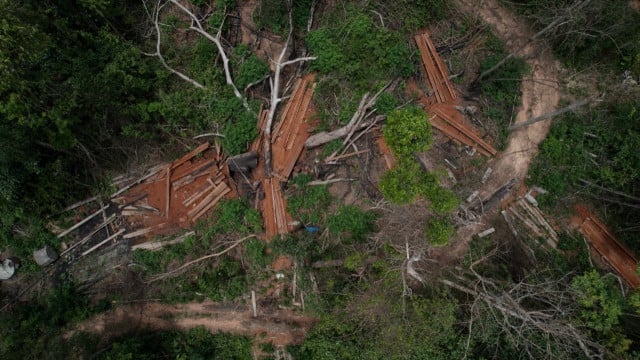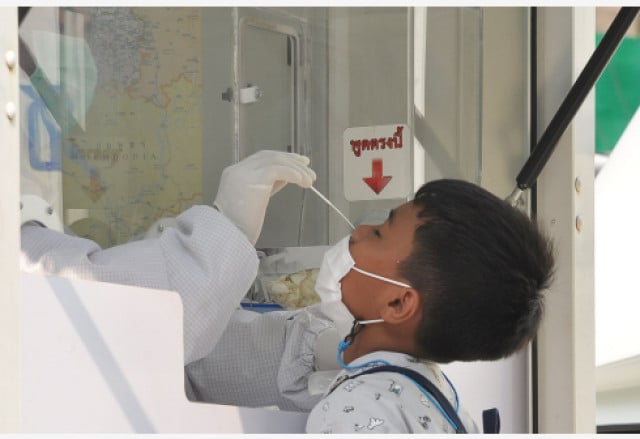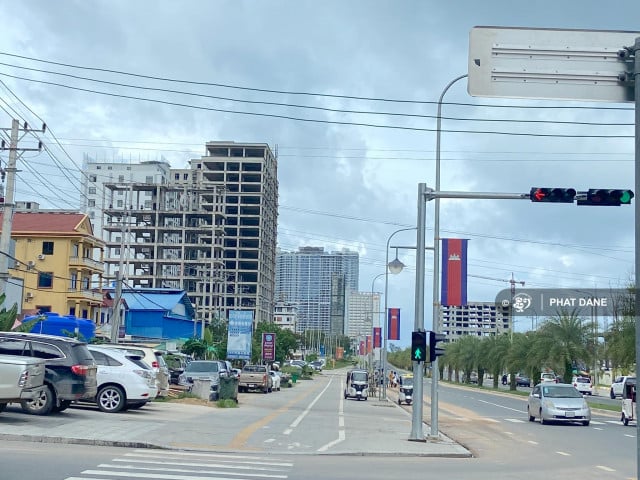Sanctuary Forest Crimes Found, Community Says

- By Lay Sopheavotey
- and Meng Seavmey
- July 21, 2022 10:53 AM
PHNOM PENH – The Kuy indigenous community in Prame village says it has found 260 cases of deforestation with 367 freshly cut planks of wood in the Preah Rokar Wildlife Sanctuary.
However, Song Chansocheat, director of Preah Vihear provincial Environment Department, denied the claim, saying these were old forest crimes that had already been dealt with.
Community members posted on Facebook on July 19 that they had updated information over 27 kilometers between map reference points X=516394, Y = 1527263 and X=508163, Y = 1529585.
“Two hundred and sixty cases of deforestation and 367 flat pieces of wood, as well as evidence such as 12 pieces of steel, diesel and gasoline were found,” they said.
“The trees were cut down ranging in diameter from 30cm to 150cm, including korki, Shorea roxburghii (porpel), Anisoptera costata (phdeak), Sindora siamensis (korkos), and eucalyptus (from which the community gets the resin).” the post said.
The community said the increase in forest crime results from the lack of capacity and willingness to protect forests and natural resources by the Environment Ministry and other authorities.
“It has had a serious impact on the livelihoods of the people, who make a living from fetching resin, environment, and the traditions of the Kuy community,” it said.
The community had made four requests to the local authorities and the ministry.
These were: Stop restricting the right and freedom to participate in activities to protect forests, natural resources of local people, indigenous people and the public as stated in Articles 21 and 29 of Protected Areas Law, and Article 35 of the Constitution.
“Broaden and create a good environment for civil society organizations, the public, and local communities to participate in activities to protect, preserve and conserve forests, natural resources, which are common property.
“Strengthen the law enforcement of local officials with effectiveness, transparency and sense of responsibility.
“Launch a mechanism to monitor the local officials’ law enforcement and punish them if they are found to be involved in bribery.”
Song Chansocheat denied that there were as many forest crimes as the community claimed.
“What on earth are those 200 to 300 cases of deforestation?” he said. “They even counted the old cases which had been cut many months or years ago. Did they know that those cases were already cracked down? They keep bringing it up,” he said.
A group from the department monitored the forest every day and had never found as many cases as suggested. There were two minor cases at most.
Heng Kimhong, an environmentalist and the Head of Research and Advocacy Program of Cambodian Youth Network (CYN), said he was concerned at the increase in forest crimes. The evidence clearly showed the correctness of the community’s claim.
“The cases found in the area are a sign that shows concerns of the local communities and indigenous ethnic minority living around and relying on the natural resources there if the illegal deforestation continues like this,” he said.
This was not the first time he had heard about deforestation in Rokar Forest. Last year, the CYN found information about the matter.
The Kuy, who rely on the natural resources in the forest, were protecting and monitoring the nature within the protected forest area in line with their rights in Articles 21 and 29 of the Protected Area Law, he said.
Article 21 says, “Local communities, indigenous ethnic minority communities, the public and civil society are encouraged to participate fully in the provision of and access to information relevant to the protected area management, conservation and development.”
Article 29 says, “Citizens, Buddhist monks, school children, civil servants, members of the armed forces, and local authorities shall have an obligation to participate in the protection, conservation and rehabilitation of natural resources within the protected areas.”
Kimhong said three things could show that trees were freshly cut.
“First, the resin on the cut trees has only been dried recently and have not gone through the burnt stage yet. Second, sawdust was seen, which means it has not been covered by anything yet. There’s no way it was done a long time ago. Lastly, the trees that were cut have not got burned yet, which gives the appearance of being newly cut,” he said.
“As Cambodia in a tropic region, the cut trees or the sawdust from the deforestation should have been burned by the wildfire months ago because it was hot in the dry season.
“As an environmentalist, I would like to ask for an investigation into those cases of illegal deforestation raised by the Kuy community. The relevant authorities should gather the information and data on the matter and start investigating.”
Kimhong thinks these freshly cut trees might be a good lead to the arrest of those responsible.
The environmentalist suggested that authorities, especially the ministry and the provincial Environment Department, should respond to this matter in a positive manner and consider this information as a primary resource for more in-depth investigation leading to those responsible for these cases.















